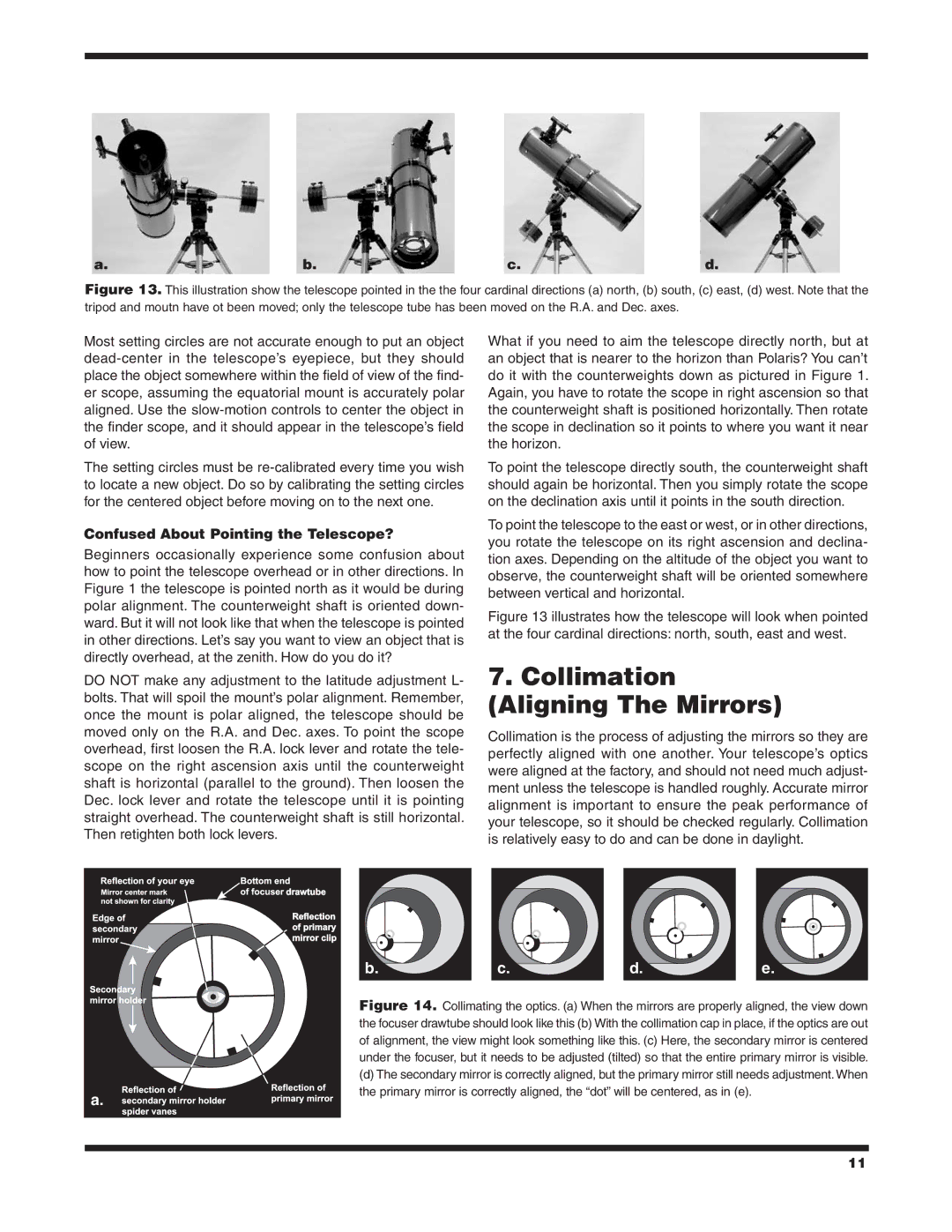
a. | b. | c. | d. |
Figure 13. This illustration show the telescope pointed in the the four cardinal directions (a) north, (b) south, (c) east, (d) west. Note that the tripod and moutn have ot been moved; only the telescope tube has been moved on the R.A. and Dec. axes.
Most setting circles are not accurate enough to put an object
The setting circles must be
Confused About Pointing the Telescope?
Beginners occasionally experience some confusion about how to point the telescope overhead or in other directions. In Figure 1 the telescope is pointed north as it would be during polar alignment. The counterweight shaft is oriented down- ward. But it will not look like that when the telescope is pointed in other directions. Let’s say you want to view an object that is directly overhead, at the zenith. How do you do it?
DO NOT make any adjustment to the latitude adjustment L- bolts. That will spoil the mount’s polar alignment. Remember, once the mount is polar aligned, the telescope should be moved only on the R.A. and Dec. axes. To point the scope overhead, first loosen the R.A. lock lever and rotate the tele- scope on the right ascension axis until the counterweight shaft is horizontal (parallel to the ground). Then loosen the Dec. lock lever and rotate the telescope until it is pointing straight overhead. The counterweight shaft is still horizontal. Then retighten both lock levers.
What if you need to aim the telescope directly north, but at an object that is nearer to the horizon than Polaris? You can’t do it with the counterweights down as pictured in Figure 1. Again, you have to rotate the scope in right ascension so that the counterweight shaft is positioned horizontally. Then rotate the scope in declination so it points to where you want it near the horizon.
To point the telescope directly south, the counterweight shaft should again be horizontal. Then you simply rotate the scope on the declination axis until it points in the south direction.
To point the telescope to the east or west, or in other directions, you rotate the telescope on its right ascension and declina- tion axes. Depending on the altitude of the object you want to observe, the counterweight shaft will be oriented somewhere between vertical and horizontal.
Figure 13 illustrates how the telescope will look when pointed at the four cardinal directions: north, south, east and west.
7.Collimation (Aligning The Mirrors)
Collimation is the process of adjusting the mirrors so they are perfectly aligned with one another. Your telescope’s optics were aligned at the factory, and should not need much adjust- ment unless the telescope is handled roughly. Accurate mirror alignment is important to ensure the peak performance of your telescope, so it should be checked regularly. Collimation is relatively easy to do and can be done in daylight.
a.
![]()
![]()
![]()
![]()
![]() drawtube
drawtube
Reflection of primary mirror clip
b. | c. | d. | e. |
Figure 14. Collimating the optics. (a) When the mirrors are properly aligned, the view down the focuser drawtube should look like this (b) With the collimation cap in place, if the optics are out of alignment, the view might look something like this. (c) Here, the secondary mirror is centered under the focuser, but it needs to be adjusted (tilted) so that the entire primary mirror is visible.
(d) The secondary mirror is correctly aligned, but the primary mirror still needs adjustment. When the primary mirror is correctly aligned, the “dot” will be centered, as in (e).
11
